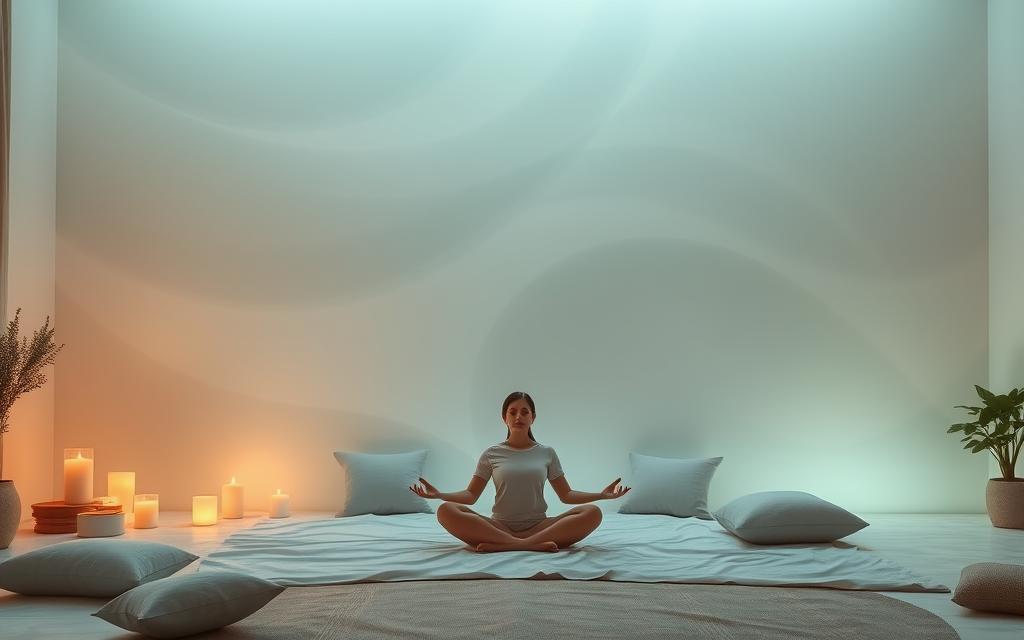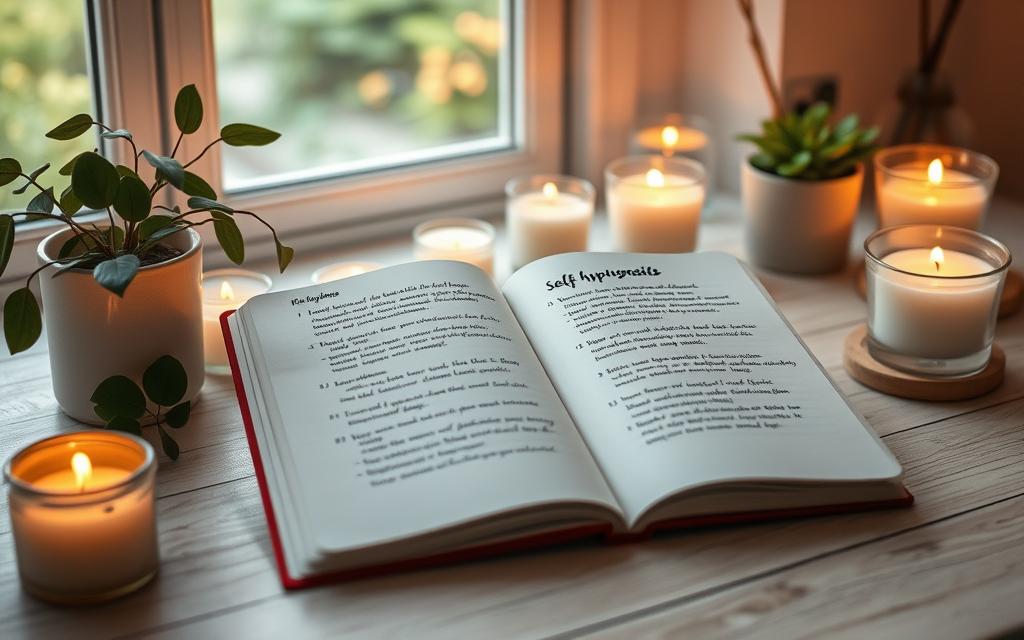Have you ever seen people perform with amazing skill, like artists and athletes? They might use self-hypnosis. This tool can help you reach your full potential and find deep inner peace.
Self-hypnosis is not just a trend. It’s backed by science and lets you use your subconscious mind. By relaxing deeply, you can access your inner strength and make lasting changes. But how does it differ from meditation, and how can it improve your life? Let’s dive into this fascinating journey together.
Imagine learning new skills easily or overcoming chronic pain and anxiety. Sounds incredible? The science behind self-hypnosis shows it’s possible. Are you ready to discover yourself and transform from within?
Understanding the Science Behind Self-Hypnosis
Explore the world of self-hypnosis and learn about its science. New discoveries in neuroscience have uncovered how hypnotic states work. They show how they can deeply affect our minds and bodies.
The Role of Brain Activity in Hypnotic States
Studies have found that self-hypnosis calms certain brain parts. These parts control things like heart rate and blood flow. This calm lets new brain paths form, connecting our conscious and subconscious.
When we’re in a self-hypnotic state, our brain’s task-switching area quiets down. But the area for daydreaming and introspection gets busier.
How Self-Hypnosis Differs from Regular Meditation
Self-hypnosis and regular meditation both make us more open to suggestions. But they differ in their focus. Self-hypnosis targets the subconscious, helping us change negative thoughts and beliefs.
This heightened awareness and focus lead to deep personal changes.
The Connection Between Conscious and Subconscious Mind
Self-hypnosis taps into the subconscious mind. This part of us holds our habits, emotions, and beliefs. By reaching this deep part of our mind, we can unlock our true potential.
Through hypnosis induction methods and self-hypnosis guided meditations, our conscious and subconscious minds work together. This teamwork helps us grow and stay well.
The Power of Everyday Trance States
Everyday trance states are common, like getting lost in a TV show or forgetting time while reading. These states show how our minds can naturally enter a suggestible state. By recognizing and using these trance states, we can improve our self-hypnosis skills. This makes it easier to change our thoughts, feelings, and actions.
About 70% of people have average hypnotizeability. Some are more or less hypnotizable, needing more practice to get better. Dr. Stephen Gurgevich, an expert, has created several self-hypnosis programs. These include The Self Hypnosis Home Study Course, Deep Sleep with Medical Self Hypnosis, and The Self Hypnosis Diet.
Self-hypnosis is a state of focused concentration. It lets you get lost in your thoughts or images. Dr. Gurgevich says all hypnosis is self-hypnosis, whether done alone or with a therapist. He also clears up the myth that hypnosis reveals secrets or behaviors.
Trance states are a normal part of being human. They happen when we’re not fully present. These states can cause daydreaming, zoning out, and altered time perception. By learning to control these states, we can change our behavior, feelings, and thoughts.

Hypnotherapy helps us connect with our unconscious mind. It blends conscious and unconscious thinking. This can change our automatic responses and emotional triggers. Whether through scripts, videos, mp3s, books, or professional services, we can use trance states for personal growth.
Essential Components of Self-Hypnosis Practice
Learning self-hypnosis needs focus on three main parts: the right environment, clear goals, and relaxation skills. These elements help unlock self-hypnosis’s power. They can boost confidence or help overcome bad habits.
Creating the Perfect Environment
Start with a quiet, comfy spot without distractions. Dim the lights and keep it cool. Remove any noise or interruptions. This calm place helps your mind relax deeply, key for self-hypnosis.
Setting Clear Intentions
Before you start, define what you want to achieve. It could be reducing stress, better sleep, or more focus. A clear goal guides your subconscious, making self-hypnosis more effective.
Mastering Relaxation Techniques
- Deep breathing exercises calm and focus the mind for self-hypnosis.
- Progressive muscle relaxation relaxes both body and mind.
- Visualization, like imagining a peaceful scene, deepens the hypnotic state.
By focusing on these key areas, you set up a great self-hypnosis practice. It unlocks the power of hypnosis for confidence and self-hypnosis for beginners.
Self-Hypnosis for Beginners: Basic Techniques and Methods
Starting your journey with self-hypnosis can be very empowering. It’s an ancient practice that leads to inner peace and personal growth. At its core, self-hypnosis uses basic techniques to unlock your subconscious mind. These techniques help you relax deeply and become more open to suggestions.
Progressive relaxation is a common method. It involves tensing and then relaxing muscle groups in your body. This leads to a deep sense of calm. Another technique is visualization, where you imagine yourself in a peaceful place. Adding positive affirmations to your practice can also help shape your thoughts and behaviors.
If you’re new to self-hypnosis, self-hypnosis guided meditations are great tools. These recordings are made by experts and guide you into a hypnotic state. By following their instructions, you can learn to enter a hypnotic state more easily and confidently.
Whether you try progressive relaxation, visualization, or guided meditations, the most important thing is to be open-minded. With regular practice, you’ll find that hypnosis techniques can help you reach your full potential and improve your well-being.

- Most people choose to be in a trance for around 15-20 minutes.
- Self-hypnosis can help improve sleep quality, alleviate chronic pain, decrease anxiety and stress, and improve digestive issues linked to Irritable Bowel Syndrome.
- Self-hypnosis is similar to meditation and can help with relaxing the mind.
- It is recommended to feel comfortable and avoid crossing legs during the self-hypnosis process.
Remember, self-hypnosis is a personal journey. What works for one person might not work for another. Be patient, try different things, and trust the process. As you explore, you’ll discover the transformative power of self-hypnosis.
The PIRATE Technique: A Step-by-Step Guide
Learning self-hypnosis can change your life. It brings inner peace, freedom, and growth. The PIRATE technique is a simple way to start self-hypnosis and reach your goals.
Privacy and Preparation
Start by finding a quiet, private spot. It should be free from distractions. Make sure it’s comfy and helps you relax deeply.
Intention Setting and Visualization
Then, think about what you want to achieve. Imagine the results you want, like less stress or more confidence. This step keeps your mind focused and your goals clear.
Achieving Deep Relaxation
After setting your goals, relax deeply. Use progressive muscle relaxation or deep breathing to calm down. When you’re relaxed, your mind is open to positive changes.
Using the PIRATE technique can unlock self-hypnosis’s power. It’s a step towards personal growth and well-being. With effort, you can see big changes in your life.
Developing Your Personal Self-Hypnosis Script
Making a self-hypnosis script for yourself is a great way to reach your goals. Good scripts use present-tense language and vivid images. They also use phrases that touch your heart to talk to your subconscious.
When you write your script, think about what you want to achieve. Use positive words and actions to help you. Add countdowns like counting from three to one to help you relax deeper.
Be humble and respectful when you practice self-hypnosis. Use God, guides, or Masters to help you. Imagine healing light filling you with positive energy.
Give your subconscious mind suggestions that it can use. Tell it to keep learning and growing. This helps you grow and get better over time.
Practice your script regularly, best on Mondays and Tuesdays. Check out the article from the day before for more tips. Learn about NLP, Gestalt therapy, and CBT.

Your self-hypnosis script should grow with you. Keep updating it to make your practice better. This way, you can reach your highest potential.
Using Self-Hypnosis for Stress Management
Self-hypnosis is a strong tool for managing stress and anxiety. It lets you tap into your subconscious mind. This way, you can spot your stress triggers and find ways to cope.
This approach not only reduces stress right away. It also makes you more resilient over time.
Identifying Stress Triggers
The first step is to know what stresses you out. Hypnosis for anxiety and self-hypnosis guided meditations help you explore your subconscious. You’ll find out what causes your stress.
This self-discovery helps you understand how you react to stress. It’s about knowing your emotional and physical responses.
Creating Effective Coping Mechanisms
- After finding your stress triggers, self-hypnosis helps you create coping strategies. You might use:
- Guided visualization to relax
- Positive affirmations to change negative thoughts
- Autogenic training for deep relaxation
- Autogenic training, started in the 1930s by Dr. Johannes Schultz, helps you relax deeply. It involves six steps.
- Regular self-hypnosis practice improves your well-being. It helps you face daily challenges calmly and focused.
Adding hypnosis for anxiety and self-hypnosis guided meditations to your day can change your life. It unlocks your subconscious mind’s power. This way, you can beat stress and live a more balanced, resilient life.
Enhancing Sleep Quality Through Self-Hypnosis
If you’re having trouble sleeping, self-hypnosis might help. Studies show it can calm your mind, reduce stress, and make sleep feel good.
A study of 90 postmenopausal women with sleep difficulties found self-hypnosis improved their sleep. It teaches your mind and body to relax and sleep better.
Self-hypnosis does more than just help you fall asleep. Research shows it can also improve slow-wave sleep and reduce anxiety and depression. These are big reasons people struggle to sleep.
Not everyone will respond to self-hypnosis, but about 15% of people are very open to it. It’s important to be open-minded and willing to explore your subconscious.
Ready to stop lying awake? Try self-hypnosis for sleep. With practice, you might find it’s a game-changer for your sleep.

While self-hypnosis is helpful, always talk to a professional for personalized advice. They can help you use hypnosis for sleep and self-hypnosis techniques to get the rest you need.
Breaking Bad Habits with Hypnotic Suggestions
Self-hypnosis is a strong tool for overcoming unwanted behaviors and bad habits. It works by changing the subconscious mind’s patterns. This way, people can replace old habits with new, healthier ones.
Understanding Behavior Patterns
Bad habits, like smoking or procrastination, start small but can become big problems. Hypnosis for motivation helps people understand why they do these things. It lets them find ways to change.
Implementing Positive Changes
With self-hypnosis scripts, people can make their own plans to change. These scripts help the mind see bad habits as bad. They encourage better choices. Doing this regularly can lead to big changes.
If self-hypnosis alone doesn’t work, getting help from a hypnotherapist can be a good idea. They offer special support and methods to help overcome bad habits.
Staying mindful, living healthily, and having friends and family support are also key. They help make hypnosis for breaking bad habits more effective.
Changing bad habits takes time, effort, and a desire for better. Self-hypnosis gives people the power to make lasting changes in their lives.
Building Confidence Through Self-Hypnosis
Boosting your confidence can change your life. Self-hypnosis is a great tool to help you. It uses your subconscious mind to overcome doubts and negative thoughts. Through positive suggestions and vivid images, you can change how you see yourself.
Many famous people, like athletes and performers, use self-hypnosis. It helps them feel more confident and perform better. Regular practice can make you feel more confident and ready for new challenges.
To start building confidence with hypnosis for confidence, try these self-hypnosis techniques:
- Find a quiet, comfortable spot to relax and focus.
- Set a clear goal for your self-hypnosis session, like “I am becoming more confident in my abilities.”
- Do deep breathing exercises to relax and focus your mind.
- Imagine yourself confidently achieving your goals or doing things that scare you.
- Repeat positive affirmations to boost your confidence and self-belief.
Building confidence through self-hypnosis takes time and practice. If you’re having trouble, consider a licensed hypnotherapist. They can help you overcome challenges and tailor the experience for you.

Self-hypnosis can unlock a new level of self-assurance. Start your journey today. Watch as your self-belief grows into a stronger, more resilient you.
Managing Anxiety and Fear with Self-Hypnosis Techniques
Self-hypnosis is a strong tool for dealing with anxiety and fear. It helps you spot anxiety patterns and find ways to calm down. Studies show that hypnotherapy can change brain areas related to anxiety and other mental health issues.
Recognizing Anxiety Patterns
To manage anxiety with self-hypnosis, first know your unique patterns. What makes you anxious? When do you feel most stressed? Knowing these helps you tailor your self-hypnosis to fit your needs.
Developing Calming Strategies
Self-hypnosis teaches you to relax deeply, change anxious thoughts, and find ways to cope with stress. Guided self-hypnosis meditations are great for reaching a calm, focused state.
Regular self-hypnosis for anxiety and self-hypnosis guided meditations can help you face fears and find peace. It connects your conscious and subconscious mind, opening doors to personal growth and well-being.
Weight Management and Self-Hypnosis
Self-hypnosis can help with weight management. It tackles the psychological reasons behind eating habits. This way, it aids in reaching weight loss goals.
Studies show hypnosis and mindfulness are good for weight loss. They improve food awareness and body image acceptance.
A study with 60 participants showed a 2-3% weight loss in 3 months. They lost an extra 8 pounds a year and a half later. Another study found the hypnosis group lost more weight than the placebo group.
Self-hypnosis techniques increase mindfulness during meals. They make you feel full, reduce cravings, and change attitudes towards food and body image. Guided visualization, positive affirmations, and mindful hypnosis are key in this process.
Using hypnosis for weight loss can tackle emotional barriers. It helps with trauma or past food-related issues. Self-hypnosis can replace negative thoughts with positive ones, leading to a healthier lifestyle.
Self-hypnosis is safe, drug-free, and non-addictive. It works well with diet, exercise, and counseling. Consistency and a holistic approach are essential for lasting results.
Measuring Your Progress in Self-Hypnosis Practice
Tracking your progress in self-hypnosis for beginners is key to staying motivated and improving your hypnosis techniques. By keeping an eye on your journey, you can spot areas to get better. This helps you make smart choices to boost your practice. Here are some good ways to track your progress:
- Keep a Journal: Writing down your experiences, feelings, and any changes in your journal is very helpful. Look back on your sessions and note any changes in stress, sleep, or how you feel overall.
- Set Specific Goals: Make clear, measurable goals that match what you want to achieve, like lowering anxiety or getting better at focusing. Check how you’re doing towards these goals often to keep yourself on track.
- Seek Feedback: Ask people you trust, like friends, family, or a mentor, for their honest thoughts on any changes they’ve seen in you since you started self-hypnosis.
Remember, self-hypnosis is a personal journey, and everyone moves at their own pace. Celebrate every small win, and be kind to yourself as you explore the amazing benefits of this practice.
Common Challenges and How to Overcome Them
Starting a self-hypnosis journey can change your life, but it comes with challenges. Two big ones are keeping your focus and dealing with distractions. But, with the right approach and effort, you can get past these obstacles.
Maintaining Focus and Concentration
Keeping your focus during self-hypnosis can be tough, mainly for beginners. Start with short sessions and slowly make them longer as you get better. Guided recordings can also help, keeping you in the moment.
Having a quiet, distraction-free spot for practice is also crucial. It helps a lot in keeping your focus sharp.
Dealing with Distractions
Distractions, whether inside your head or from outside, can mess up your self-hypnosis. To fight this, reduce distractions by turning off devices and finding a quiet spot. Make sure your space is comfy and helps you relax.
Learning about self-hypnosis techniques and hypnosis induction methods can also help. It makes you understand and enjoy the process more, keeping you focused.
Being persistent and patient is essential for mastering self-hypnosis. Regular practice and a strong will to overcome hurdles will improve your hypnotic state. This unlocks the full power of this mindfulness practice.
Conclusion
Self-hypnosis is a powerful tool for finding inner peace and managing stress. It helps with personal growth too. By learning about self-hypnosis and practicing, you can change your life for the better. It can reduce stress, improve focus, and boost creativity.
Starting your self-hypnosis journey means being open-minded and patient. Change takes time, but it’s worth it. With regular practice, you can reach your full potential and find peace.
Every person’s journey with self-hypnosis is different. Enjoy the process, celebrate your wins, and ask for help when you need it. This will help you live a more fulfilling and empowered life.
